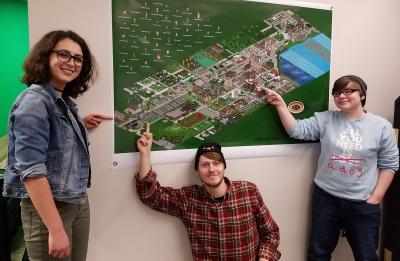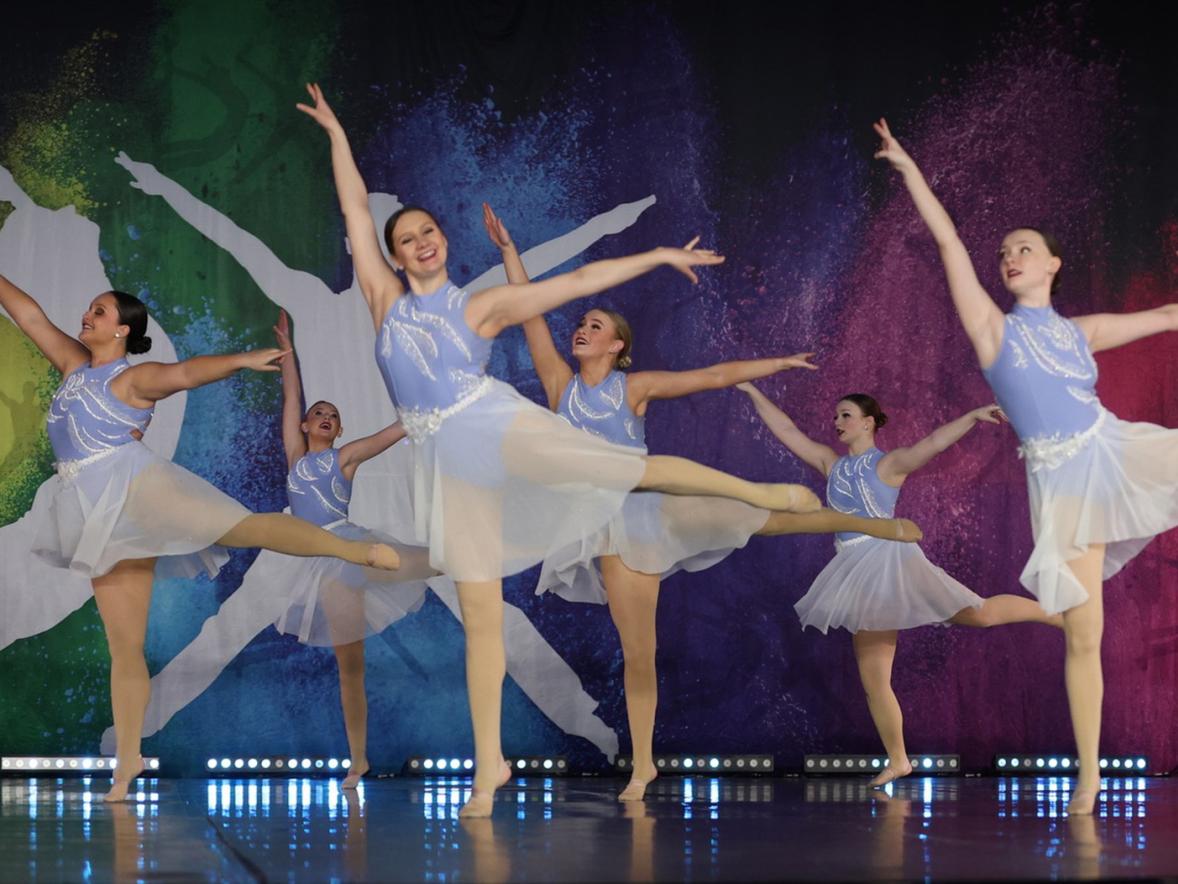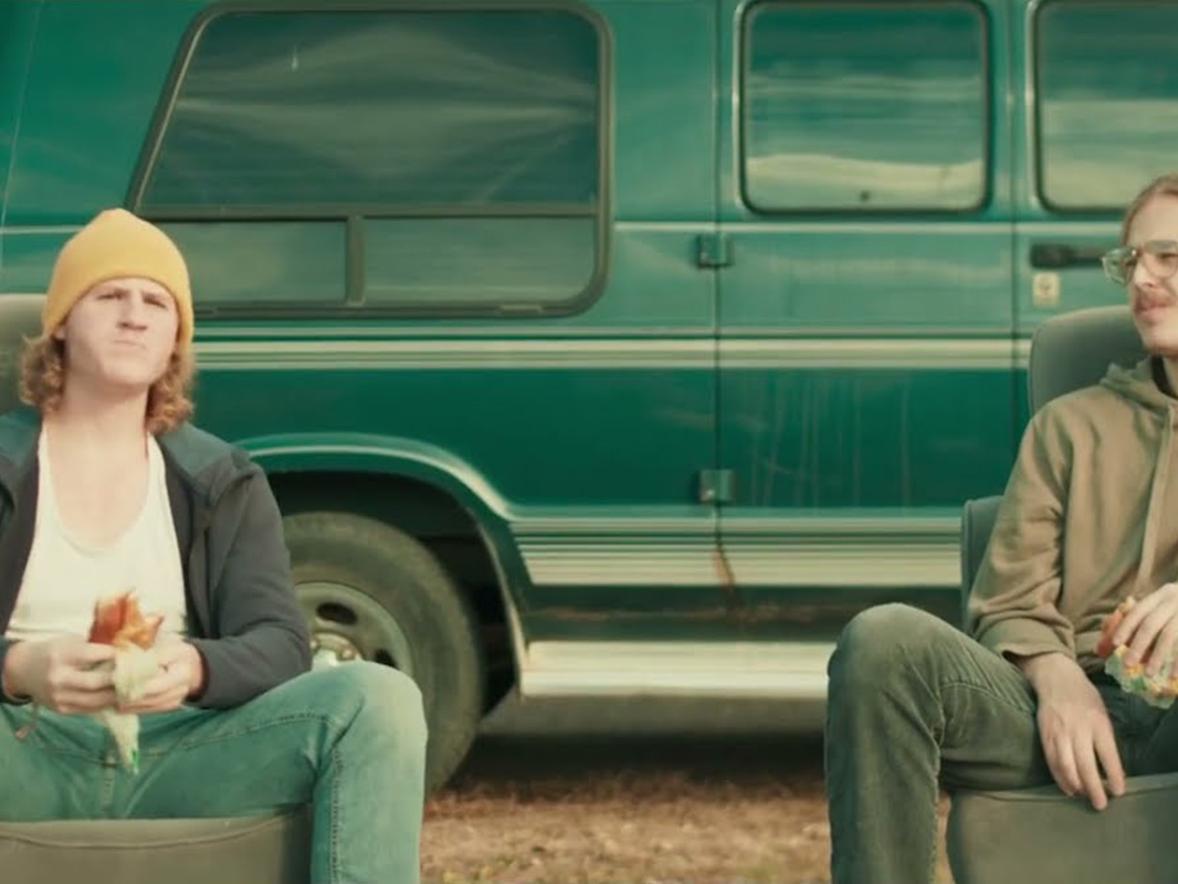Students in Lecturer Karl Koehle’s Pixel and Vector Art courses contributed to the creation of a UW-Stout campus map in pixel art style. Forty-two students from two classes worked for four weeks developing more than five-hundred digital layers of custom content.
Lecturer Koehle divided the campus and surrounding area into city blocks, assigning each student an individual section, or tile, of the map-to-be.
“We created a basic ground-plan of the map’s tiles with grid-lines running parallel to each other in an isometric view," explained Koehle. "With no focal point in the horizon, each city block is in equal proportion to those adjacent, giving each student an equally-sized tile to develop. To work within this isometric view forces students to create art within restraints.”
With their individual tile in mind, students visited Heather Stecklein at the University Archives to learn about the history of campus buildings and to acquire a bird’s eye view of the area using other maps for reference.
“With their research complete, the students were ready to begin the development process," Koehle said. "Even with this daunting task ahead of them, they responded with excitement from the get-go.”
Let the creative juices flow
Although their map would not be interactive, students drew inspiration from pixel art video games such as SimCity, Undertale, Stardew Valley, Cave Story, and Army of Trolls.
“Pixel art has a special niche. It has a nostalgic factor and level of appreciation,” said Kristen Protheroe, a senior majoring in Animation and Digital Media. “Pixel art is rampant in the indie movement. It cuts down on work and is easier to create more content. It’s efficient and allows for two artists to do the work of twenty."
Using Adobe Photoshop and Piskel, an online tool focused on the creation of pixel art, students developed custom content included buildings, walkways and streets, waves on Lake Menomin, and objects on and around campus.
“Piskel is designed for animators but is intuitive enough for anyone to use it," Protheroe said. "It’s free and has all you need, with the freedom to export your work.”
Piskel also has the capability to create a color palette. As a team, the students agreed on a palette of thirty-two colors.
“Sharing a color palette with forty-two collaborators gave our map a sense of cohesion," explained Jace Brockopp, a sophomore in Game Design and Development. "Everything ties together. Everything fits well.”
After developing the first layer of tiles, usually of a solid color to represent road or grass or water, students submitted the layers to Koehle. Subsequent layers became more and more detailed as the project progressed.
“I populated the layers in Photoshop, placing the tiles onto a digital grid, layering levels one by one," Koehle said. "I kept a code of each layer and each tile within each layer, knowing where to place it within the grid and tracking each student’s progress.”
Campus buildings and area businesses began to take shape and became recognizable as more and more layers were developed and stacked. Environmental assets like cars, light posts, sculptures, and fish in the lake were added. Characters like Godzilla, jack-o-lanterns, and UFOs give each tile personal flair.
The color palette evolved when it came time to add foliage to trees. With each student having his or her own perception of what a tree should look like, there are green trees, leafless trees, and trees with changing leaves. All four seasons are represented at once on the map. Some trees appear as though a particular block of Stout were located in the jungle.
To top it all off, students created personal avatars to live within the map itself, with each avatar representing the students’ own aesthetics. A key to the avatars is included in the map, crediting the forty-two collaborators. They even thought to add the challenge of “Where’s Walda?”.
These touches invite viewers to take a closer look and appreciate the details that make the map unique.
“It’s quirky because it represents each of us,” said Syd Simonis laughing, a sophomore in Game Design and Development. “It would be dull if it were all one style, but it still fits our campus’s style.”

Detours, roadblocks and additional constructions
While some tiles consisted of more layers than others, the library with its multiple angles and levels for instance, seemingly simpler tiles like those of the lake took no less skill to develop. The tiles of the lake required developing repeating textures, a difficult skill-set to master.
Challenging items to create included the track-and-field, the football field, and the smokestack. To develop this content, students needed to employ isometric curves, ensuring their math was consistent and pixels strategically placed.
“One pixel out of place could throw off each layer to follow,” Simonis said.
Simonis developed the tile including the smokestack and utility buildings. Being one of the tallest structures on campus, and with its curved surface, the smokestack took a considerable amount of time to develop. But because the map is not interactive, when the final layers were pieced together, the library covered up the view of the utility buildings.
“I think I spent six to ten hours a week outside of class working on my tile. You really have no free-time as an art student. It’s just what we do,” Simonis said. “But now, part of my work is not visible. That’s frustrating.”
After completing their assigned tiles, some students requested to develop additional tiles, extending the boundaries of the original map to include parks and homes west of campus.
“My home is nearby, and the first draft of city blocks didn’t include it,” Protheroe said. “But I wanted to create my home, so we expanded the map a little. The more I look at it, the happier I am with it.”
Brockopp, who developed the football field and area houses, also developed a tile for the climbing wall which had not been included in the original borders of the map.
“This was a part of campus I was unfamiliar with,” Koehle admitted. “I didn’t know Stout had a climbing wall. I learned from this assignment right along with my students.”
Final product and future goals
A six-by-three-foot printed poster, complete with a list of the forty-two students who contributed to the map, was on display during the fall 2018 Stout Game Expo.
“There was a lot of buzz at SGX,” said Zach Olson, a sophomore in Game Design and Development, who designed the library tile. “We showed how well the project really melded. It sums up our campus nicely.”
Lecturer Koehle believes this campus map is the first of its kind.
“I don’t know of any other university which has created a project of this scale, with forty-two students at this level in pixel art," Koehle said. "I hope in another semester to create a campus map angled with a view from north campus, or create maps for other UW campuses. I’m very impressed with the level of talent our students have.”
Although the pixel-art-campus-map is not interactive, Koehle would like to see it as an app to incorporate into the existing app for visiting students and the public to access during tours.
The campus map is archived in digital and print format at the University Archives and is a permanent showcase of the students’ talent. It is released under the Creative Commons License Agreement.
Contributors from two classes are included on the map itself and in the text below.
DES225-001 AMApolloni, Nathaneal Allan, Stone Bourgoin, Emily Ceranski, Joe Fortney, Allen Haakana, Joshua Huftel, Ike Kilmer, Ryan Krekelberg, Amy Lee, Mallory Miller, Hannah Peterson, Haley Sanders, Nick Schultz, Timothy Scott, Charlotte Stieg, Dan Swensen, Callie Thomas, Lucas VanBrocklin, Matt Wussow, Noah |
DES225-002 PMAnderberg, Victoria Barber, Keenan Brockopp, Jace Bruckbauer, Joshua Bultman, Laura Edinger, Aubrey Estrada, Jose Fischer, Alex Grunwald, Katharine Klitz, Jacob Kukura, Philip Mahoney, Brooke Olson, Zack Patterson, Ash Phillips, Whitney Protheroe, Kristen Renshaw, Erin Shaffer, Emily Simonis, Syd Wegner, Emily Zenz, Katelyn |






